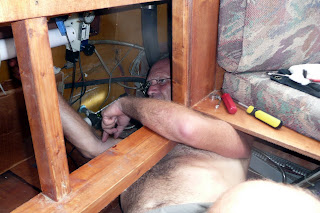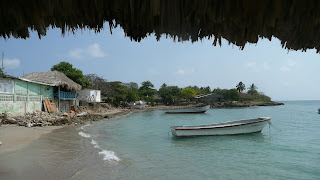
We left Isla Fuertes at 10 AM and had a great sail almost the whole way. Later that night we had to motor sail as the wind died down but that kind of peaceful eventfree night on the water is very welcome. We took turns on watch as usual and both got some sleep. Early the next morning we could see the mountains of Panama in the distance and soon the palm lined islands of the Kuna Yala (Land of the Kuna Indians), known on most maps in spanish as the San Blas.

We were nervous entering the reef but kept a good visual watch on the water and our navigation charts. Once inside the outer reef there are many small island groups. We were headed first for the Eastern Coco Bandares. It was the perfect time of day for the eyeball navigation necessary to thread our way through the coral reefs into a perfectly protected, absolutely gorgeous anchorage. Friends there on "See U Manana" gave us some helpful advice on the entrance and soon we were anchored in paradise.

Several other boats were there although it couldn't be called crowded. Two of them we had met before in Cartagena, both with five month old babies! The scene on the beach nearby that afternoon was charming. That's the two babies having a bath in the water and playing with the four parents on the right (double click on the picture to see a close up of the babies).

This island group does not have any permenant Kuna residents. They come out in their ulas (wooden dugouts) to gather coconuts and sell molas or fruits, fish and vegetables. We bought a huge stem of small bananas and hung it on the back of our boat. Yes, they do all seem to ripen at once! They were green, green, green and then suddenly - they're all yellow. I made three banana breads over a week's time - plus of course, banana pancakes etc.

We did a lot of kyacking around to the islands and reefs for snorkeling. The water was crystal clear and the snorkeling very good. The coral and vegetation was particularily nice although we didn't see the amount and variety of fish we saw in Bonaire. We swam constantly and read the rest of the time. That's "Scott Free" at anchor on the right.

We've really enjoyed our two person kyack and have ventured out into rougher waters occasionally and found it very stable. Scott wants to try some surfing down the waves but we haven't found a good spot away from the coral reefs. We keep it up on the bow tied down when we're not using it and it has it's own sunbrella fabric zippered cover to protect it from the sun.

We didn't move the boat an inch for five days. It was great just sitting still for a change!
























































